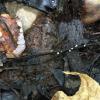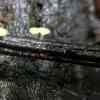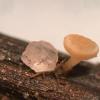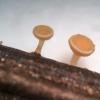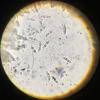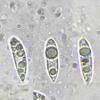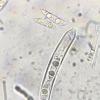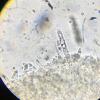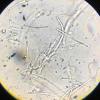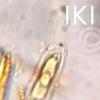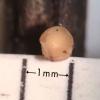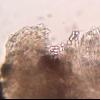
12-11-2025 09:25
 Viktorie Halasu
Viktorie Halasu
Hello, I need help with a pale terrestric Pseudom

11-11-2025 20:16
Bohan JiaHi, lastly I have found these tiny yellow decayin

09-11-2025 13:20
Hello.A tiny ascomycete, appearing as erupting gra

08-11-2025 00:29
 Francois Guay
Francois Guay
I found this species in Quebec, Canada, on herbace
Hymenoscyphus ?
Ethan Crenson,
05-09-2019 20:40
Found by a friend last weekend in a New York City park. Growing in a small creek on what could be a twig of hardwood, or the stem of a leaf, or perhaps some other kind of stem. I think this is Hymenoscyphus. The fruiting bodies are waxy, stipitate, perhaps 1mm tall and 1mm in diameter at the most. Asci are 80-82 x 8-9µm IKI+. Spores are hyaline, fusiform, sometimes with one end rounded and the other pointed, guttulate, measuring around 19-20 x 4.5-5µm. Paraphyses are vermiform, not enlarged at the ends for the most part. Is this Hymenoscyphus? Maybe Hymenoscyphus caudatus?
Thank you in advance.
Ethan
Hans-Otto Baral,
05-09-2019 20:49

Re : Hymenoscyphus ?
This looks clearly like a petiole. The blackening of the substrate points to H. albidus, but I am unaware of this species occurring in America.
H. caudatus is an aggregate. Helpful is to clarify whether the asci arise from croziers or simple septa. Also I am not sure about the VBs in the living paraphyses,m are they strongly refrcative like oil drops?
Since the closeup shows apos on a rather undarkened petiole, I am not fully sure they are the same as the others.
Zotto
H. caudatus is an aggregate. Helpful is to clarify whether the asci arise from croziers or simple septa. Also I am not sure about the VBs in the living paraphyses,m are they strongly refrcative like oil drops?
Since the closeup shows apos on a rather undarkened petiole, I am not fully sure they are the same as the others.
Zotto
Ethan Crenson,
05-09-2019 21:03
Re : Hymenoscyphus ?
I am almost completely certain that the petiole in the in situ photos and the one from my dissecting microscope photos are one and the same. I assumed that the color shift in both the fungi and the petiole was due to them drying out in my refrigerator for 5 days. I will attempt to get better documentation of the base of the asci. Zotto, apologies, but could you explain for me what VBs is an abbreviation for? Thank you.
Ethan
Hans-Otto Baral,
05-09-2019 21:56

Re : Hymenoscyphus ?
VBs are refravtive vacuolar bodies. They look like oil drops (lipid bodies, LBs) but unlike LBs they disappear in KOH or when pressing on the cover slip.
Martin Bemmann,
05-09-2019 22:11

Re : Hymenoscyphus ?
And this (red arrow in the attachment) is a Fraxinus samara (seed).
Most probably Fraxinus nigra, if we look for North American species:
Regards
Martin

